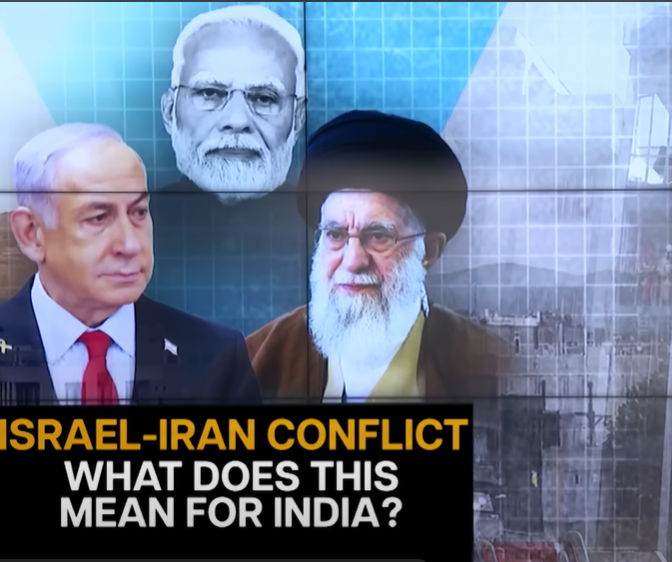– Abdul Bari Masoud
On the night of June 13, air raid sirens blared across Tehran and Tel Aviv. Israel had launched a series of precision strikes on Iranian nuclear and military facilities, prompting a swift and furious response from Tehran in the form of long-range missile attacks. What followed was one of the tensest flashpoints in the Middle East since the Syria crisis a decade ago. As international media scrambled to report on the rapidly unfolding war, most of the Indian television news channels known for their servile attitude also leapt into action. But instead of offering depth or balance, much of their coverage leaned into sensationalism, hyper-nationalism, and geopolitical simplification as happened during the recent India-Pakistan conflict.
This story examines how leading Indian television networks framed the Iran-Israel conflict – how headlines screamed war, how thumbnails dramatised destruction, and how Iran’s voice was all but erased in favour of Western and Israeli narratives.
As the world watched anxiously, Indian television news channels kicked into high gear. However, instead of sober analysis, viewers were subjected to what has now become a familiar formula: sensationalism, selective outrage, and strategic omission. The coverage of this international crisis by leading Indian broadcasters followed a predictable arc – one that blurred the line between journalism and jingoism.
Headlines Roared
The coverage was loud. Headlines from Republic TV declared “Iran’s Nuclear Dreams Obliterated,” while Times Now framed the crisis with panic: “World War 3?” News18 added its own breathless spin with phrases like “Tehran Burns” and “Trump Warns Iran.” Hindi channels like Aaj Tak deployed emotionally charged words like “tabahi” (destruction) to amplify the stakes.
Yet amid this bombastic language, Iranian perspectives were curiously absent. While Israeli spokespeople and Western analysts were featured extensively, Iranian officials’ statements rarely made it to screen. Civilian casualties inside Iran were either minimised or ignored, even as outlets like Al Jazeera reported over 600 deaths.
This imbalance wasn’t coincidental. Indian TV news has long been accused of aligning its foreign policy framing with that of the ruling government. With Israel being one of India’s most significant defence partners – supplying cutting-edge drones, missiles, and cybersecurity infrastructure – many channels implicitly or explicitly mirrored a pro-Israel stance.
The Lapdog Critique
On X, the term “lapdog media” trended briefly as netizens called out Indian broadcasters for parroting Israeli and American lines. One viral post mocked the Indian press for broadcasting IDF-provided animations of Iranian targets without verification, accusing them of becoming mouthpieces for foreign governments.
In some cases, these criticisms had merit. Multiple Indian channels repeated claims of Iranian strikes on civilian locations in Israel, while failing to interrogate Israel’s own controversial tactics – like storing munitions in urban buildings, a claim made by critics but rarely scrutinised on Indian TV.
The Thumbnails
Visuals have always been a core driver of Indian news consumption, especially in the TV space. Thumbnails for segments on the Iran-Israel war were awash with fireballs, collapsing buildings, missile trails, and close-ups of crying children. The bombing of Iran’s state broadcaster, IRIB, became a recurring visual trope, with some channels looping the footage of a fleeing anchor as if to underscore Iran’s chaos.
Channels like Times Now, NDTV, India Today, and Republic made heavy use of breaking news banners, often with sirens or flashing red graphics to maintain a sense of emergency. Even developments already covered by international outlets were repackaged as “exclusive” or “urgent.”
Among the five major English and Hindi news broadcasters analysed, NDTV came closest to offering balance. It aired Iranian Supreme Leader Ayatollah Khamenei’s statement condemning Israeli aggression and briefly highlighted the humanitarian crisis in Tehran.
However, even NDTV leaned into the same dramatic thumbnail strategy, relying on real-time visuals from Reuters and social media. A segment titled “Tehran Responds” included dramatic visuals of missile launches but little contextual reporting on why Iran viewed the strikes as a violation of its sovereignty.
Anchors Praised Modi
One element that united almost all channels was the elevation of India’s evacuation efforts into a centrepiece of coverage. “Operation Sindhu,” the mission to bring home Indian students and workers from conflict zones, was presented as a logistical and diplomatic masterstroke. Anchors praised Prime Minister Modi’s leadership, some going so far as to suggest that his intervention “paused” the war – a claim later debunked by fact-checkers.
Thumbnails for these segments featured the Indian flag, returning evacuees, and PM Modi’s face superimposed on maps of the region. This narrative reinforced India’s image as a neutral, humanitarian power while conveniently sidestepping tougher questions about the geopolitical alignments in play.
Structural Bias
The erasure of Iranian voices wasn’t solely a product of editorial laziness. It pointed to deeper structural dependencies. Indian newsrooms rely heavily on Western news agencies like AFP, Reuters, and AP for international footage and updates. These agencies, in turn, often prioritise access and sourcing from U.S. and Israeli institutions.
Moreover, with Iranian state media offering limited access and English-language materials, Indian outlets may find it easier to reproduce narratives already established by their Western counterparts. In doing so, they risk embedding the biases of those sources into their own coverage.
Fear-Mongering and Misinformation
A worrying trend during the Iran-Israel coverage was the proliferation of outright false information. Some reports on Indian TV suggested that Iran was preparing a nuclear strike – despite the IAEA confirming no radiation leaks or evidence of escalated enrichment activity. Other segments claimed that the U.S. used Indian airspace for strikes, a rumour that the Indian Ministry of External Affairs later denied.
These exaggerations served to heighten viewer anxiety and maintain high engagement levels. But they also eroded trust, especially among viewers who later learned the claims were unfounded.
Perhaps the most glaring omission in Indian TV coverage was the absence of human stories from Iran. There were plenty of visuals – damaged buildings, chaotic hospitals – but few, if any, interviews with Iranian civilians, aid workers, or independent analysts who could provide a grassroots perspective.
In contrast, Israeli voices – from spokespersons to ordinary citizens – were featured far more regularly. This disparity made the war appear lopsided not only militarily but also morally, casting Israel as reactive and Iran as the aggressor.
The Iran-Israel conflict was undoubtedly newsworthy, with far-reaching implications for global security, oil markets, and regional diplomacy. But Indian television news chose spectacle over substance, urgency over understanding. Sensational thumbnails, exaggerated headlines, and selective sourcing painted a simplified picture – one where Israel defended, Iran threatened, and India rescued.
The critique wasn’t baseless. Channels such as Republic and India Today repeatedly aired unverified claims, including reports that Iranian missiles had struck Israeli kindergartens – allegations that were later denied by the Israeli government itself.
Lost in this equation were the realities on the ground in Iran, the voices of its people, and the nuances of international law and diplomacy.
In a media landscape driven by ratings and the Hindutva fervour, Indian audiences deserve journalism that informs, not inflames – that illuminates, rather than obscures. Until that shift happens, the war in the Middle East will continue to be filtered not through the lens of clarity, but through a smokescreen of spectacle.




